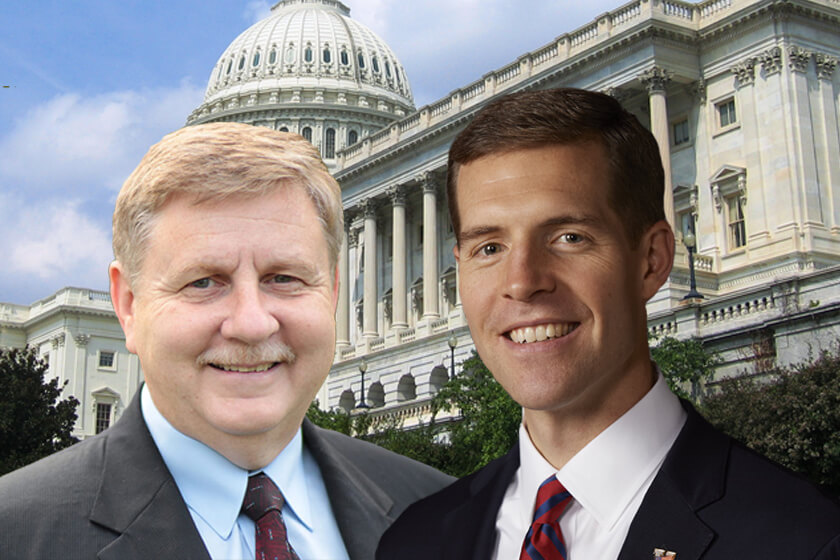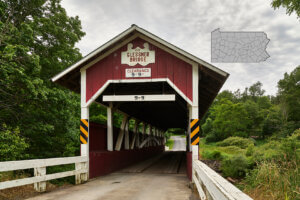West Long Branch, NJ – Democrat Conor Lamb has taken a lead over Republican Rick Saccone in the special election for Pennsylvania’s 18th Congressional District. The Monmouth University Poll finds PA18 voters are divided on whether recently announced steel tariffs will help or hurt the local economy, but very few say this policy will influence their vote in Tuesday’s election to fill the open House seat.
Lamb holds a 51% to 45% lead over Saccone if turnout yields a Democratic surge similar to voting patterns seen in other special elections over the past year. Another 1% opt for a third party candidate and 3% are undecided. Lamb also has the edge using a historical midterm lower turnout model, albeit by a much smaller 49% to 47% margin. A model with higher turnout overall, similar to a presidential electorate, gives Lamb a 51% to 44% advantage. This marks a turnaround from last month’s Monmouth poll of the race, when Saccone held a small lead in all the models – 49% to 46% in the surge model, 48% to 44% in the high turnout model, and 50% to 45% in the low turnout model.
“This district has voted overwhelmingly Republican in recent elections, but a large number of these voters have blue-collar Democratic roots. Lamb seems to have connected with them,” said Patrick Murray, director of the independent Monmouth University Polling Institute.
Lamb earns a net positive 53% favorable and 33% unfavorable rating from likely voters in PA18. Opinion is somewhat more divided on Saccone at 47% favorable and 43% unfavorable. Fully 95% of self-identified Democrats support Lamb (to 5% for Saccone), while 88% of self-identified Republicans support Saccone (to 9% for Lamb). Independents prefer Lamb by a 51% to 45% margin.
It’s not clear whether Donald Trump’s decision to impose tariffs on foreign steel is doing much to help Saccone’s chances, although most of the interviews for this poll were conducted prior to Saturday night’s presidential rally. Just 3% of likely voters say they moved toward supporting Saccone in the past week because of the tariffs, while 1% say they moved toward voting for Lamb. Fully 96% of likely voters, though, report that the tariff announcement did nothing to change their vote in this race. A bare plurality of likely PA18 voters say that the tariffs will help (43%) the local area’s economy, but a sizable number (36%) feel these tariffs will actually hurt the region. Another 8% say the tariffs will have no impact and 13% are not sure what the impact will be.
“Voters are divided on the potential impact of tariffs. It doesn’t seem that the president’s gambit paid off in this race if that was his intent. But the poll was largely conducted before Trump’s rally Saturday night and we don’t have a clear picture of what impact that might hold. A Saccone victory is still well within the poll’s margin of error, especially if a Democratic surge does not materialize in the Pittsburgh suburbs,” said Murray.
The poll finds that likely voters in PA18 are divided on the president’s overall job performance – 49% approve and 49% disapprove. Last month, Trump earned a slightly positive 51% approve and 47% disapprove rating. Voters who approve of Trump are somewhat more likely to support the Democrat Lamb (7% to 90% for Saccone) than voters who disapprove of Trump are to support the Republican Saccone (2% to 96% for Lamb).
The district’s electorate continues to be divided over which party they prefer to see in control of Congress, with an even split between the Democrats (42%) and the Republicans (42%). Last month, the GOP held a slight edge (43% to 40%). Still, likely voters in PA18 give similarly negative ratings to the Republican Party (44% favorable and 48% unfavorable) and the Democratic Party (44% favorable and 47% unfavorable).
“When added to a potential Democratic surge that has been building for weeks, Lamb appears to have picked off enough Republican-leaning voters to take a lead going into this contest’s final weekend. It would mark an extraordinary swing from Trump’s nearly 20 point victory here in 2016 if he could hold on to win,” said Murray.
The multiple turnout models used in this poll are similar to Monmouth’s polling for December’s special U.S. Senate election in Alabama. The key difference between the Democratic “surge” model and the standard low turnout model in PA18 is an increase in the districtwide vote share coming from historically Democratic-leaning and competitive precincts. Most of these precincts are located in Allegheny County with some in neighboring Washington County. These precincts typically make up about 19% of PA18’s electorate in any given election. The surge adjustment increases that share to 21%.
The Monmouth University Poll was conducted by telephone from March 8 to 11, 2018 with 503 registered voters in Pennsylvania’s 18th Congressional District. Results in this release are based on the responses of 372 likely voters for Tuesday’s special election and have a margin of error of +/- 5.1 percent. The poll was conducted by the Monmouth University Polling Institute in West Long Branch, NJ.
* The results in this section use “surge” model weighting based on recent special election turnout patterns. Other turnout weights referenced in this release produce estimates that are no more than 2 to 3 percentage points different than the results reported here.
QUESTIONS AND RESULTS
(* Some columns may not add to 100% due to rounding.)
1/2. If the election for U.S. Congress in your district was today, would you vote for … Rick Saccone the Republican or Conor Lamb the Democrat, or some other candidate?
[IF UNDECIDED: If you had to vote for one of the following at this moment, do you lean more toward Rick Saccone or more toward Conor Lamb?] [NAMES WERE ROTATED]
| Likely voters with leaners | March 2018 | February 2018 | ||||
|
“Surge” |
High |
Low |
“Surge” |
High |
Low | |
| Rick Saccone | 45% | 44% | 47% | 49% | 48% | 50% |
| Conor Lamb | 51% | 51% | 49% | 46% | 44% | 45% |
| Other | 1% | 1% | 1% | 1% | 2% | 1% |
| (VOL) Undecided | 3% | 4% | 3% | 4% | 5% | 4% |
| (n) | (372) | (394) | (372) | (320) | (379) | (320) |
[QUESTIONS 3 & 4 WERE ROTATED]
3. Is your general impression of Rick Saccone very favorable, somewhat favorable, somewhat unfavorable, or very unfavorable, or do you have no opinion of him?
| March 2018 | February 2018 | |
| Very favorable | 29% | 27% |
| Somewhat favorable | 18% | 21% |
| Somewhat unfavorable | 13% | 14% |
| Very unfavorable | 30% | 25% |
| No opinion | 10% | 13% |
| (n) | (372) | (320) |
4. Is your general impression of Conor Lamb very favorable, somewhat favorable, somewhat unfavorable, or very unfavorable, or do you have no opinion of him?
| March 2018 | February 2018 | |
| Very favorable | 36% | 29% |
| Somewhat favorable | 17% | 20% |
| Somewhat unfavorable | 12% | 17% |
| Very unfavorable | 21% | 14% |
| No opinion | 14% | 20% |
| (n) | (372) | (320) |
5. How much interest do you have in the upcoming special election for U.S. Congress – a lot of interest, a little interest, or not much interest at all?
| March 2018 | February 2018 | |
| A lot | 87% | 83% |
| A little | 11% | 16% |
| Not much at all | 2% | 1% |
| (VOL) Don’t know | 0% | 0% |
| (n) | (372) | (320) |
6. Have you been following the campaign for U.S. Congress very closely, somewhat closely, or not too closely?
| March 2018 | February 2018 | |
| Very closely | 55% | 38% |
| Somewhat closely | 40% | 51% |
| Not too closely | 4% | 12% |
| (VOL) Don’t know | 0% | 0% |
| (n) | (372) | (320) |
7. Do you approve or disapprove of the job Donald Trump is doing as president? [Do you (approve/disapprove) strongly or somewhat?]
| March 2018 | February 2018 | |
| Strongly approve | 39% | 37% |
| Somewhat approve | 10% | 14% |
| Somewhat disapprove | 8% | 5% |
| Strongly disapprove | 41% | 42% |
| (VOL) Don’t know | 2% | 2% |
| (n) | (372) | (320) |
8. Did you hear about President Trump’s recent decision to impose tariffs on foreign steel and aluminum, or didn’t you hear about this?
| March 2018 | |
| Heard | 95% |
| Not heard | 5% |
| (n) | (372) |
9. Do you think these tariffs will help, hurt, or have no impact on the economy in this part of Pennsylvania?
| March 2018 | |
| Help | 43% |
| Hurt | 36% |
| Have no impact | 8% |
| (VOL) Don’t know | 13% |
| (n) | (372) |
10. Has the steel tariff announcement caused you to change your mind in the last week about who you are going to support in Tuesday’s Congressional election, or hasn’t it changed your mind? [If YES: Has it made you more likely to support Saccone, more likely to support Lamb, or has it made you more undecided?
| March 2018 | |
| Yes, more likely to support Saccone | 3% |
| Yes, more likely to support Lamb | 1% |
| Yes, more undecided | 0% |
| No, has not changed my mind | 96% |
| (VOL) Don’t know | 1% |
| (n) | (372) |
[NO QUESTION 11]
[QUESTIONS 12 & 13 WERE ROTATED]
12. Is your general impression of the Republican Party very favorable, somewhat favorable, somewhat unfavorable, or very unfavorable, or do you have no opinion?
| March 2018 | February 2018 | |
| Very favorable | 16% | 12% |
| Somewhat favorable | 28% | 29% |
| Somewhat unfavorable | 17% | 18% |
| Very unfavorable | 31% | 34% |
| No opinion | 8% | 6% |
| (n) | (372) | (320) |
13. Is your general impression of the Democratic Party very favorable, somewhat favorable, somewhat unfavorable, or very unfavorable, or do you have no opinion?
| March 2018 | February 2018 | |
| Very favorable | 16% | 12% |
| Somewhat favorable | 28% | 32% |
| Somewhat unfavorable | 14% | 16% |
| Very unfavorable | 33% | 35% |
| No opinion | 9% | 6% |
| (n) | (372) | (320) |
14. Would you rather see the Republicans or the Democrats in control of Congress, or doesn’t this matter to you?
| March 2018 | February 2018 | |
| Republicans | 42% | 43% |
| Democrats | 42% | 40% |
| Does not matter | 12% | 16% |
| (VOL) Don’t know | 4% | 1% |
| (n) | (372) | (320) |
[NO QUESTION 15 OR 16]
17. How important is it for you personally to get involved in politics – very important, somewhat important, not too important, or not at all important?
| March 2018 | February 2018 | |
| Very important | 41% | 46% |
| Somewhat important | 42% | 37% |
| Not too important | 10% | 9% |
| Not at all important | 6% | 5% |
| (VOL) Don’t know | 1% | 1% |
| (n) | (372) | (320) |
METHODOLOGY
The Monmouth University Poll was sponsored and conducted by the Monmouth University Polling Institute from March 8 to 11, 2018 with a random sample of 372 likely voters in Pennsylvania’s 18th Congressional District, drawn from a list of registered voters who voted in at least one of the last four general or primary elections or have registered to vote since January 2016, and indicate they are likely to vote in the upcoming special election. This includes 252 contacted by a live interviewer on a landline telephone and 120 contacted by a live interviewer on a cell phone. Monmouth is responsible for all aspects of the survey design, data weighting and analysis. Final sample is weighted for region, party primary voting history, age, gender, and race based on state voter registration list and U.S. Census information. Data collection support provided by Braun Research (field) and Aristotle (voter sample). For results based on this sample, one can say with 95% confidence that the error attributable to sampling has a maximum margin of plus or minus 5.1 percentage points (unadjusted for sample design). Sampling error can be larger for sub-groups (see table below). In addition to sampling error, one should bear in mind that question wording and practical difficulties in conducting surveys can introduce error or bias into the findings of opinion polls.
| DEMOGRAPHICS (weighted) |
Party Registration |
| 46% Republican |
| 50% Democrat |
4% Neither |
Self-Reported Party ID |
| 38% Republican |
| 24% Independent |
| 39% Democrat |
| 48% Male |
| 52% Female |
8% 18-34 |
| 18% 35-49 |
| 37% 50-64 |
| 37% 65+ |
| 96% White, non-Hispanic |
4% Other |
| 56% No college degree |
| 44% 4-year college degree |
| 42% Allegheny County |
| 24% Washington/Greene County |
| 34% Westmoreland County |
Click on pdf file link below for full methodology and results by key demographic groups.




